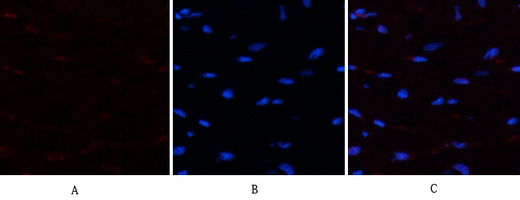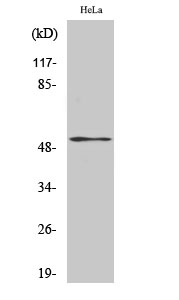PTEN (phospho Ser380) Polyclonal Antibody
- Catalog No.:YP0238
- Applications:IHC;IF;ELISA
- Reactivity:Human;Mouse;Rat
- Target:
- PTEN
- Fields:
- >>Inositol phosphate metabolism;>>Metabolic pathways;>>EGFR tyrosine kinase inhibitor resistance;>>FoxO signaling pathway;>>Phosphatidylinositol signaling system;>>Sphingolipid signaling pathway;>>p53 signaling pathway;>>Autophagy - animal;>>mTOR signaling pathway;>>PI3K-Akt signaling pathway;>>Cellular senescence;>>Focal adhesion;>>Insulin resistance;>>Human papillomavirus infection;>>Human T-cell leukemia virus 1 infection;>>Pathways in cancer;>>MicroRNAs in cancer;>>Chemical carcinogenesis - reactive oxygen species;>>Endometrial cancer;>>Glioma;>>Prostate cancer;>>Melanoma;>>Small cell lung cancer;>>Breast cancer;>>Hepatocellular carcinoma;>>Central carbon metabolism in cancer;>>PD-L1 expression and PD-1 checkpoint pathway in cancer;>>Diabetic cardiomyopathy
- Gene Name:
- PTEN
- Protein Name:
- Phosphatidylinositol 3,4,5-trisphosphate 3-phosphatase and dual-specificity protein phosphatase PTEN
- Human Gene Id:
- 5729
- Human Swiss Prot No:
- P60484
- Mouse Gene Id:
- 19211
- Mouse Swiss Prot No:
- O08586
- Immunogen:
- The antiserum was produced against synthesized peptide derived from human PTEN around the phosphorylation site of Ser380. AA range:366-395
- Specificity:
- Phospho-PTEN (S380) Polyclonal Antibody detects endogenous levels of PTEN protein only when phosphorylated at S380.
- Formulation:
- Liquid in PBS containing 50% glycerol, 0.5% BSA and 0.02% sodium azide.
- Source:
- Polyclonal, Rabbit,IgG
- Dilution:
- IHC 1:100 - 1:300. ELISA: 1:10000.. IF 1:50-200
- Purification:
- The antibody was affinity-purified from rabbit antiserum by affinity-chromatography using epitope-specific immunogen.
- Concentration:
- 1 mg/ml
- Storage Stability:
- -15°C to -25°C/1 year(Do not lower than -25°C)
- Other Name:
- PTEN;MMAC1;TEP1;Phosphatidylinositol 3;4,5-trisphosphate 3-phosphatase and dual-specificity protein phosphatase PTEN;Mutated in multiple advanced cancers 1;Phosphatase and tensin homolog
- Observed Band(KD):
- 55kD
- Background:
- This gene was identified as a tumor suppressor that is mutated in a large number of cancers at high frequency. The protein encoded by this gene is a phosphatidylinositol-3,4,5-trisphosphate 3-phosphatase. It contains a tensin like domain as well as a catalytic domain similar to that of the dual specificity protein tyrosine phosphatases. Unlike most of the protein tyrosine phosphatases, this protein preferentially dephosphorylates phosphoinositide substrates. It negatively regulates intracellular levels of phosphatidylinositol-3,4,5-trisphosphate in cells and functions as a tumor suppressor by negatively regulating AKT/PKB signaling pathway. The use of a non-canonical (CUG) upstream initiation site produces a longer isoform that initiates translation with a leucine, and is thought to be preferentially associated with the mitochondrial inner membrane. This longer isoform may help regulate ener
- Function:
- catalytic activity:A phosphoprotein + H(2)O = a protein + phosphate.,catalytic activity:Phosphatidylinositol 3,4,5-trisphosphate + H(2)O = phosphatidylinositol 4,5-bisphosphate + phosphate.,catalytic activity:Protein tyrosine phosphate + H(2)O = protein tyrosine + phosphate.,cofactor:Magnesium.,disease:A microdeletion of chromosome 10q23 involving PTEN and BMPR1A is a cause of chromosome 10q23 deletion syndrome [MIM:612242]. This syndrome shows overlapping features of the following three disorders: Bannayan-Zonana syndrome, Cowden disease and juvenile polyposis syndrome.,disease:Defects in PTEN are a cause of Bannayan-Zonana syndrome (BZS) [MIM:153480]; also known as Ruvalcaba-Riley-Smith or Bannayan-Riley-Ruvalcaba syndrome (BRRS). In BZS there seems not to be an increased risk of malignancy. It has a partial clinical overlap with CD. BZS is characterized by the classic triad of macroce
- Subcellular Location:
- Cytoplasm . Nucleus . Nucleus, PML body . Monoubiquitinated form is nuclear. Nonubiquitinated form is cytoplasmic. Colocalized with PML and USP7 in PML nuclear bodies (PubMed:18716620). XIAP/BIRC4 promotes its nuclear localization (PubMed:19473982). .; [Isoform alpha]: Secreted . May be secreted via a classical signal peptide and reenter into cells with the help of a poly-Arg motif.
- Expression:
- Expressed at a relatively high level in all adult tissues, including heart, brain, placenta, lung, liver, muscle, kidney and pancreas.
- June 19-2018
- WESTERN IMMUNOBLOTTING PROTOCOL
- June 19-2018
- IMMUNOHISTOCHEMISTRY-PARAFFIN PROTOCOL
- June 19-2018
- IMMUNOFLUORESCENCE PROTOCOL
- September 08-2020
- FLOW-CYTOMEYRT-PROTOCOL
- May 20-2022
- Cell-Based ELISA│解您多样本WB检测之困扰
- July 13-2018
- CELL-BASED-ELISA-PROTOCOL-FOR-ACETYL-PROTEIN
- July 13-2018
- CELL-BASED-ELISA-PROTOCOL-FOR-PHOSPHO-PROTEIN
- July 13-2018
- Antibody-FAQs
- Products Images

- Immunohistochemistry analysis of paraffin-embedded human breast cancer, using PTEN (Phospho-Ser380) Antibody. The picture on the right is blocked with the PTEN (Phospho-Ser380) peptide.
.jpg)

